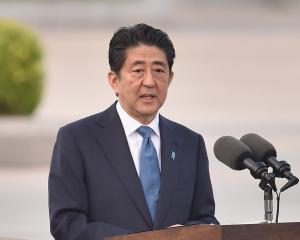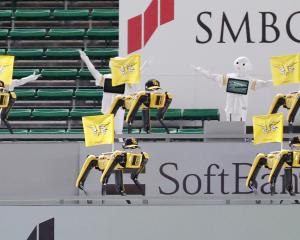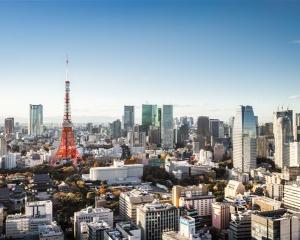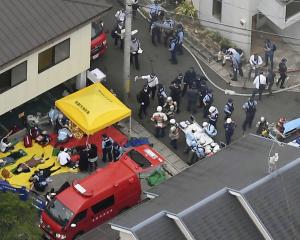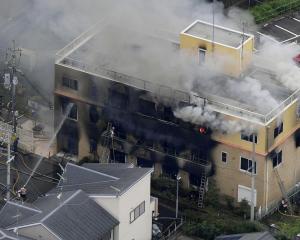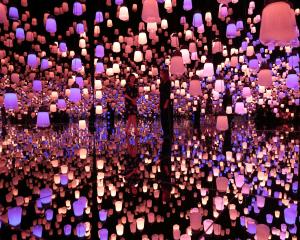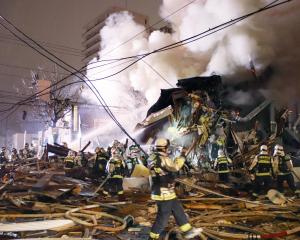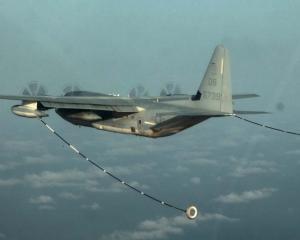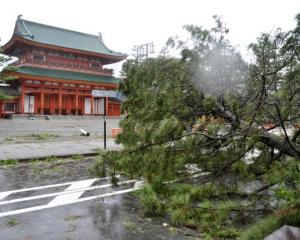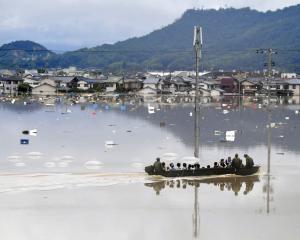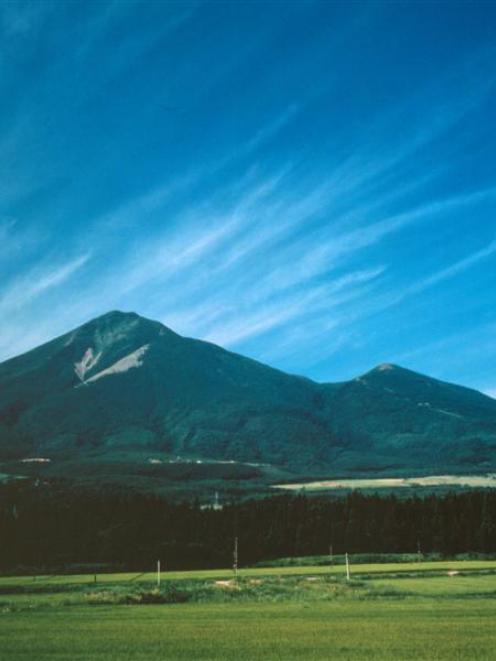
Let's hope that if we are ever silly enough to build our own local atomic reactor, we wouldn't call it "Otago No1 Power Station", thereby tarring an entire province with the nuclear brush.
The ill-fated Fukushima No1 shares its name with fairly unscathed Fukushima City, separated from the radiation hazard by coastal mountain ranges and the various 20km to 40km exclusion zones. Beyond even the larger 80km zone suggested by foreign governments, including New Zealand's, but still in Fukushima prefecture, is the stunning Urabandai district.
Bandai-san volcano looms 1800m high over the achingly beautiful Hibara-ko lake, where lush forests spill straight into the water.
"Urabandai" means "behind Bandai" and refers to the alpine basin created when the volcano blew itself apart on July 15, 1888, creating a massive avalanche that closed off two valleys.
These Fukushima folk are accustomed to disaster; they lost 461 villagers on that day.
From the debris, about a third of the volcano's collapsed caldera, Fukushima prefecture gained two new lakes. Over the ensuing decades, during Japan's rapid industrialisation, they developed a tourist industry for Tokyo's newly upwardly mobile workers, and a new hydro-electricity resource for the megacity's bright lights and humming factories. Tokyo Electric Power Co didn't even need dams; they just plumbed their turbines into the landslip.
The firm latterly well known worldwide as Tepco left its mark all over Urabandai: their property markers stamped with the Japanese characters "To Den" (their local abbreviation, short for "Toyo Denki") dot the landscape to assert their ownership of the lake and foreshore. The corporation therefore has a long history in the area, and locals are accustomed to its tendency to giveth and taketh away.
Tepco has had the influence our old Ministry of Works had around Cromwell and the Mackenzie Country, "improving" the landscape with penstocks and pylons and leaving tidy camping areas and parklands in their wake.
It was my pleasure to work in Matsubara Camp, on Hibara-ko lake, over two summers. My employers, Satoshi and Naoko Matsuzaki, were beneficiaries of Tepco largesse, with a management licence to operate a camping site on the foreshore.
Matsubara Camp has one huge advantage: there is no road. All access is by boat or on foot; there is no "motor camp" rattle and clutter of oversized family vehicles, just quiet groups in tents or the little on-site huts, watching the daily ebb and flow of the lake's electric storage and that of their own electronic gadgets.
My travel agent in Dunedin told me she got a job as a riding instructor on the basis of being a New Zealander. I exploited my citizenship fully and was engaged as a canoe and yacht guide on the lake. Being a New Zealander also qualified me to carry all the guests' camping gear (invariably brand-new, luxurious and heavy) from the boat to their tent sites, where my nationality also enabled me to help pitch their tents.
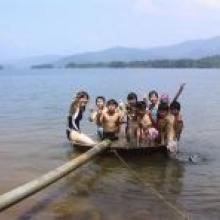
The Matsuzakis close Matsubara Camp each autumn and retreat to their winter quarters, a huge, comfortable Canadian-designed log-house.
Maintaining the practical Japanese tradition of the nuclear family all sleeping in one room, they made the four-bedroom house a three-room guesthouse.
In winter, the Urabandai district is utterly transformed from its subtropical summer heat. The lakes freeze over and the real tourism starts: they have a five-month ski season in which visitor numbers far exceed the summer peak. The skifields cut pistes through the forested mountainsides, so they appear quite different from our rock and tussock alpine resorts, where skiing through trees is rare.
The ski season keeps the Matsuzakis' log-house full of guests, fed hearty Tohoku cuisine of piping-hot winter stews.
To take a break from skiing, the hosts offer snowmobile rides, ice fishing through a hole in the lake, and soaking in the various thermal springs around the lake. Facilities at these range from the poshest hotel apres-ski pool complexes to those family water-world places, and my favourite, the old fibreglass pool we towed across the lake and fed from a rusty brown stream with bits of drainpipe, soaking for free in sulphurous water the colour of miso soup. All thermal resorts are strictly togless, which takes a bit of getting used to, but everything is segregated, except for the occasional foreigner who can't understand the signs.
With so much geothermal energy, it is frustrating that Japan fails to exploit it to provide the same sort of constant base-load electricity generation that their nuclear industry provides, but at far lower potential for disaster. The current geothermal electricity industry is about 0.3% of the size of its nuclear generating capacity.
Mr Matsuzaki supplements his tourism income by driving the local snow-plough run. Roads in the area resemble canyons as the snow is piled as high as a double-decker bus on each side.
The roads are marked with poles the size of street lamps to show where to dig. They do infrastructure very well in Japan, with a seemingly endless supply of cash and concrete. All places are reached even in deepest winter by regular public transport (from Tokyo by bullet train, local train then bus), and a most civilised facility, Japan's baggage-delivery services, which can whisk your bags from apartment to hotel to airport with flawless efficiency.
Like all of Japan's countryside, Fukushima is so pleasant to visit that it seems a pity that it is left almost entirely to the nation's own domestic tourists. Hotels and transport lie idle for months at a time while the Japanese are busy at work. This means that every spring and autumn, while the forested mountainsides are either confettied with blossom or ablaze with reddening foliage, the temperature extremes are absent and so are the crowds. No traveller, on business or leisure, should miss the chance to escape the high-tech cities and check Japan's rural side: jump on the Shinkansen and contemplate theirony while your nuclear-powered electric bullet train speeds you back to nature.
How they got on
After several days of wondering how my former employers had fared, I reached Mrs Matsuzaki by telephone and she told me she and her family were safe.
The Matsuzakis feel safe from the problems at Fukushima nuclear power plant because there are so many mountains in between.
It remains to be seen whether real or perceived radiation hazards will affect their visitor numbers.
Mr Matsuzaki said later that although earthquake damage to buildings was minor, the tsunami and nuclear events had been very serious for people throughout northeastern Japan, and very few were engaging in leisure such as skiing.
"I need my job," he said.
• Peter Dowden is a Warrington writer.
If you go
All the Pacific coastline of Japan's Tohoku region has been affected by the disaster to some extent.
Earthquake damage is more widespread, but is minor compared with the tsunami devastation.
There are areas that are unsafe, including the nuclear exclusion zone, and a few places, as in parts of Christchurch, where disaster tourists are certain to be unwelcome.
The Japan National Tourism Organisation (JNTO) advises of shortened business hours by tourist-oriented businesses, but says "the restoration work has been progressing day by day".
The New Zealand Government Safetravel website advises against all tourist and other non-essential travel in areas most directly affected by the earthquake and tsunami, and suggests an 80km radius from the nuclear accident.
The JNTO's own figures corroborate the suggestion: Fukushima City, which sits inside this enlarged zone, has much higher radiation than normal.
The normal route to reach Urabandai would briefly skirt this 80km zone.
Urabandai accommodation provided by Satoshi and Naoko Matsuzaki:Matsubara Camp (open June-August): Hibara-ko lake, tel 0081 241 32 2247 Loghouse Mori no Uta (open September-May): Kitashiobara, tel 0081 241 33 2929.
Baggage delivery:
Wherever you go in Japan, the baggage delivery service is so good, you will wonder how you have ever managed without it. Drop your bags off at the GPA counter at Narita Airport (there's one in every terminal), and they will bring it to your hotel or private address in Tokyo not much after you can get there by train or bus.
They can also advise you how to use the service in the opposite direction. The cost of about $NZ30 per bag seems expensive, but combined with a cheap train fare, it easily beats bag-friendly taxi travel.

